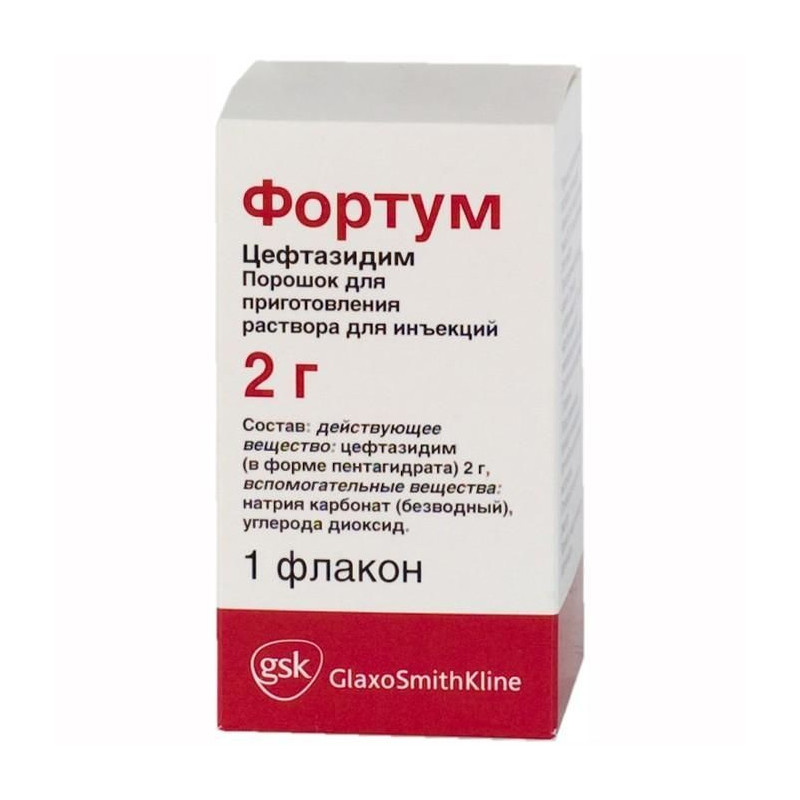



 All payments are encrypted via SSL
All payments are encrypted via SSL
 Full Refund if you haven't received your order
Full Refund if you haven't received your order
Fortum - powder for solution for injection:
1 fl. contains ceftazidime (in the form of pentahydrate) 250, 500, 1000 and 2000 mg,
excipients: sodium carbonate (anhydrous); carbon dioxide;
in a pack of cardboard 1 bottle.
Fortum has a broad spectrum antibacterial effect, bactericidal.
Severe infections, including nosocomial infections (septicemia, bacteremia, peritonitis, meningitis, infections in immunocompromised patients, infected burns); respiratory tract infections and infections in patients with cystic fibrosis; infections of ENT organs; urinary tract infections; skin and soft tissue infections; infections of the digestive tract, biliary tract and abdominal cavity; infections of bones and joints; dialysis infections; prevention of infectious complications during operations on the prostate gland (transurethral resection).
Hypersensitivity to ceftazidime or any other component of Fortum and to other cephalosporin antibiotics, penicillins.
There is no evidence of embryotoxic or teratogenic effects of ceftazidime, however, Fortum should be used with caution in women in the first months of pregnancy and newborns.
Ceftazidime is excreted in breast milk, so care must be taken when prescribing the drug to nursing mothers.
Local reactions: phlebitis or thrombophlebitis with a / in the introduction of Fortum; pain, burning, tightness at the injection site with the / m introduction.
Hypersensitivity reactions: maculopapular rash, urticaria, fever, pruritus, angioedema, bronchospasm, lowering blood pressure, exudative erythema multiforme (including Stevens-Johnson syndrome), toxic epidermal necrolysis (Layell syndrome).
On the part of the digestive tract: diarrhea, nausea, vomiting, abdominal pain; oropharyngeal candidiasis, colitis. As with the use of other cephalosporins, colitis can be caused by Clostridium difficile and manifest itself as pseudomembranous colitis.
On the part of the urogenital system: candidal vaginitis, impaired renal function.
On the part of the hepatobiliary system and the pancreas: very rarely - jaundice.
From the side of the central nervous system: headache, dizziness, paresthesia, a violation of taste. In patients with renal failure, neurological disorders are more common than others, including tremor, myoclonus, seizures, encephalopathy, and coma.
From the laboratory parameters: eosinophilia, false positive direct Coombs reaction, thrombocytosis, increased activity of liver enzymes - ALT, ATT, LDH, gamma-glutamyl transpeptidase and ALP. Sometimes there is a transient increase in the level of urea, urea nitrogen and / or creatinine in the blood.
From the side of blood-forming organs: leukopenia, neutropenia, agranulocytosis, thrombocytopenia, lymphocytosis, hemolytic anemia.
Fortum is introduced in / in or in a / m deep into the upper outer quadrant of the gluteus maximus or the lateral part of the thigh.
The ceftazidime solution can be injected directly into the vein or into the tube of the infusion system.
The dose of Fortum is set individually depending on the severity of the course of the disease, localization, type of pathogen and its sensitivity to the drug, as well as the patient's age and kidney function.
The maximum daily dose of Fortum - 6 g.
Adults: 1-6 g / day in 2 or 3 doses of IV / IM, for most infections, usually 1 g every 8 hours or 2 g after 12 hours for severe infections, especially in immunocompromised patients ( including patients with neutropenia) - 2 g every 8 or 12 hours or 3 g every 12 hours; for urinary tract infections and lung infections, 500 mg or 1 g every 12 hours; cystic fibrosis - 100-150 mg / kg / day in 3 doses; during operations on the prostate gland - 1 g during induction anesthesia, the second dose is administered during removal of the catheter.
Children older than 2 months: 30-100 mg / kg / day in 2-3 doses, with reduced immunity, cystic fibrosis and meningitis - up to 150 mg / kg / day (6 g / day maximum) in 3 doses.
Newborns and infants up to 2 months: 25-60 mg / kg / day in 2 divided doses.
Elderly patients, especially patients older than 80 years: no more than 3 g / day.
In the dark place at a temperature of no higher than 20 ° C.
